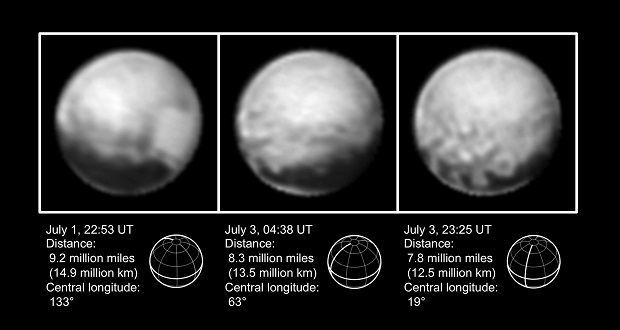Spacecraft closing in on Pluto hits speed bump, but recovers

This combination of images from July 1 to July 3, 2015, provided by NASA shows Pluto at different distances from the New Horizons spacecraft. NASA’s New Horizons spacecraft is on track to sweep past Pluto next week despite hitting a “speed bump” that temporarily halted science collection. (NASA via Pluto)
CAPE CANAVERAL, Florida, United States — NASA’s New Horizons spacecraft is on track to sweep past Pluto next week despite hitting a “speed bump” that temporarily halted science collection.
A computer overload prompted the spacecraft to partially shut down on July 4th — just days before the first-ever close flyby of Pluto. Flight controllers managed to regain contact with the spacecraft in just over an hour and correct the tense situation, occurring after a relatively quiet journey of 3 billion miles (4.83 billion kilometers) and 9½ years.
“We’re on to Pluto!” NASA’s director of planetary science, Jim Green, assured journalists Monday.
New Horizons will pass closest to Pluto on July 14. The spacecraft will come within 7,750 miles (12,470 kilometers) of the mysterious, tiny, icy world out on the fringes of the solar system.
About 2½ days of science observations were lost because of the problem. That represents about 30 observations out of 500 planned over the next week.
Principal scientist Alan Stern said it was more important to recover the spacecraft than worry about some lost observations of a Pluto still several million miles away. Data collection is expected to resume Tuesday, one week before the long-awaited flyby.
“While we prefer that this event hadn’t occurred … this is a speed bump in terms of the total return that we expect from this flyby,” said Stern, who is with the Southwest Research Institute in Boulder, Colorado. Pluto and its big moon Charon already are surprising scientists with their surface appearances, “and we’re excited to get back to that,” he added Monday.
Stern as well as others involved in the mission said they do not expect the problem to re-occur.
The main computer was multi-tasking in preparation for the big event coming up — and dealing with heavier, more complex data loads than expected — when the trouble arose. The spacecraft went into its so-called safe mode, and science operations ceased. Contact was restored through its backup computer.
No changes were made to the flyby plan as a direct result of Saturday’s problem, according to officials.
New Horizons — about the size of a baby grand piano — was launched from Cape Canaveral, Florida, in 2006. It was designed and built by Johns Hopkins University’s Applied Physics Laboratory in Laurel, Maryland, which also is managing the $700 million mission for NASA. That’s where the New Horizons flight control team is based.